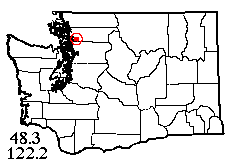
Spider Collector's Journal (14th page: 2004) Copyright © 2005 by Rod Crawford
As explained on the first page, most of these notes of fun (and not so fun) trips to collect spiders for research at the Burke Museum appeared in Scarabogram, newsletter of "Scarabs: The Bug Society," in their original forms. References to the editor mean me; most other persons mentioned are Scarabs members. Dates of field trips head each paragraph. Maps showing the location of sites within Washington state follow the grid system outlined in the Washington Spider Checklist. RETURN TO INDEX
 |
10 IV 2004: The first spider collecting trip of 2004 (April 10) was to the Mt. Vernon area with Sonja Watson, who was producing a short video documentary on yr editor (it since aired on KCTS and at 3 film festivals) and wanted some field footage! Also along was able assistant Jerry Austin; Sonja's friend Eli drove. We wanted to visit a marsh near Little Mountain, but were stymied by lack of access, so on to Plan B, a trail leading through various habitats to the summit of Devils Mountain (near Big Lake). Habitats sampled included mixed forest; the brushy environs of a small marsh which had (alas) been clearcut and (even more alas) the clearcut was growing those nasty introduced blackberries; and the rocky, shrubby Devils Mountain summit ridge. The 28 spider species included few surprises but all were useful locality records. The day concluded in one of the area's many Mexican restaurants. And yes, the footage made it into the film.
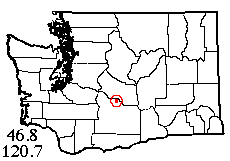 |
30 IV 2004: On April 30, Jerry and I headed for eastern Washington with my botanical artist friend Louise Smith. After rejecting assorted sites as not being flowery enough, we stopped at a mid-elevation section of the north fork of Wenas Creek. Available habitats were an extensive cottonwood forest between the road and the creek, various small riparian marshes and meadows, and a rocky slope of open Ponderosa pine with Purshia and Ribes. My pitfall traps benefited from sunshine which made the wolf spiders active. Collecting seemed good at the time, but a surprising number of the spiders turned out to be worthless immatures; however, we did get 21 species including Jerry's capture of a very cool, as-yet unidentified member of the ant mimic genus Castianeira.
 |
6 V 2004: Yr editor's friend Della likes to soak in hot springs, and in 2000 we'd visited Baker Hot Spring on the south slope of Mt. Baker, where I'd got a moderately good spider collection and then lost the fullest vial of spiders! So on May 6 (4 years later to the day), we returned to try to make up the loss (and do some more soaking). The missing moss-sift collection was replaced in an hour or so, so I and Jerry hiked down to a marsh meadow we'd found on the latest topo map of the area. This marsh is less than a mile from the hot spring but only reached by a roundabout hiking trail. It turned out to be a truly outstanding spot! In a deep valley between forested hills, a trickle stream has been dammed by beavers at numerous points over many years, making a cedar swamp with just enough devil's club to make it interesting and an extremely varied complex of marshes with sedge, skunk cabbage, Vaccinium and assorted herbage. There is even a little area starting to grow bog mosses. Fairly solid beaver dams give access through the soggiest parts. The 49 species included some interesting microspiders and crab spiders; even the short-term pitfall traps back at the parking lot had good wolf spiders. But ah, that marsh: a gorgeous spot, a real paradise we'd highly recommend to all wetland lovers.
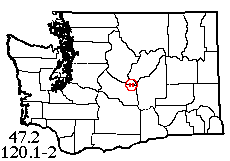 |
9-11 VII 2004: On 9-11 July, yr editor (with Scarab Huntzinger and Jerry
Austin) accompanied Scarab Sugden's entomology class to Colockum Field Station
in the foothills of the Wenatchee Mountains, where oddly enough, I'd never been
before. Given first choice of cabins at the station, I picked the one I thought
would have the most spiders, but there weren't many inside. I set pitfall traps
in the grounds (6 species over the 2 days including an Antrodiaetus and
a new jumping spider for the state) and got a few others from vegetation, but
the fauna at 2050' was clearly past its prime. Next day, the class visited higher
sites up the North Fork of Colockum Creek and Jerry and I spent most of the
day at the highest site (4920') which had talus, subalpine forest and small
riparian meadows, getting about 35 species from meadow and forest vegetation,
willow litter, under stones, etc. There were larch trees along the upper forest
edge whose foliage was especially productive, as it often is in Russia. Also
on the 10th, a nice set of dictynid spiders were taken from rabbit brush along
the road just above the station. With dusk approaching, Kim and I went up a
trail across the creek from the station to visit more lowland rabbit brush and
a pine grove, but didn't get much. At night, the students mercury-vapor lighted
on the station grounds, but the catch was nowhere near what might have been
expected. I suspect the moth fauna would be better if this was done far from
the station's artificial lights. UV searching for fluorescent scorpions produced
at least one.
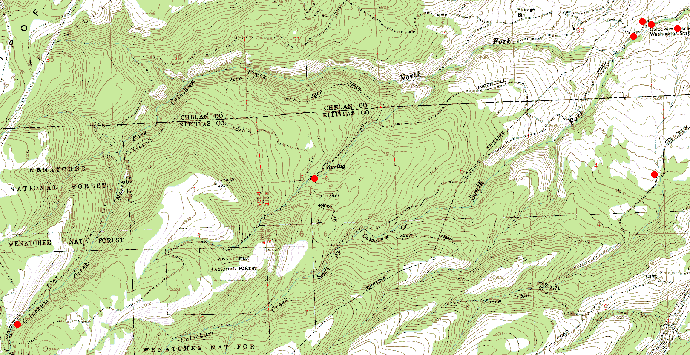 |
| 2004 spider sites near and above Colockum Field Station (in NE corner of map). Warning: do not trust student labels from this area! Students collect at sites spanning the 16-square-mile, two-county, many-habitats area shown and are encouraged to use the same locality label for all! Is this a science class? |
On the last day, Jerry and I had free use of one of the vehicles, and visited an intermediate elevation site that had good spiders (one unfamiliar to me) on fir foliage and pine bark. We then visited a site on the other side of the station (away from the mountains) off Colockum Road with open pine forest and lush mesic-looking glades. Among other additions to the list, the beautiful silvery Euryopis formosa was taken there. Waiting for departure, I thought what the heck, might as well try sifting the almost bone dry cottonwood litter right behind the station. Surprisingly, it had 7 spider species including the uncommon jumping spider Sitticus sylvestris. All in all, results were good for a midsummer trip. Jerry got a nice array of bee flies (his current interest that week).
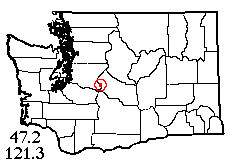 |
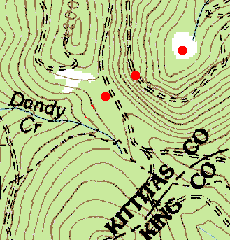 |
| Sites around Dandy Creek. Weather station is off map to east |
14 VIII 2004: Yr editor's friend Jacque lives part of the time in splendid isolation at the Stampede Pass weather station (3963'), many miles from the nearest dwelling. NOAA has announced the closure of the station and last summer Jacque was expecting to have to move full time to her other home in Bellingham any day, but in fact the closure has moved so glacially that she's still there now (with no snow and blooming daffodils in February). However, I thought I'd better visit her there while I still had the chance, so on August 14 I headed up to the area with Jerry Austin and our friend Della, along to provide a picnic. We first collected on a 4200' elevation ridge crest that (following a fire) has developed vegetation just like subalpine parkland. Then down the east side of the ridge to the Meadow Creek drainage, where there was Sitka alder litter by the road and an unexpectedly hard-to-reach meadow farther down. Jerry thought he was doing great, sweeping in this meadow, so imagine his disgust to find that 90% of his catch was unidentifiable immature Dictyna. Among the interesting catches in this area were two spiders (Zelotes rainier and Coreorgonal petulcus) almost always found at or above treeline, which have here colonized the lower but treeline-like habitat. At Jacque's house, I got 2 Eurasian house spider species (Pholcus phalangioides and Tegenaria domestica) indoors that are probably the only populations of their species for many miles around. The full sample was low on species and will have to be supplemented, but that's only what one expects in August, worst month of the year for spiders.
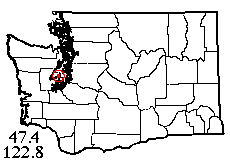 |
11 XI 2004: On 11 November, after completing a private job in the Hood Canal area, I found myself with a hired car and driver (a Russian from Belarus as it turned out) at my disposal and 3+ hours of daylight left. A nature preserve called Theler Wetlands at the very head of the canal had been suggested to me as a likely spot, and worked out very well. This is quite a sizable area near Belfair with second growth forest, large (partly modified) estuarine marsh, and an essentially pristine alder-cedar swamp. Click here for their map. From swamp leaf litter, estuarine grass, conifer foliage and education-center buildings, 31 species were taken in the very short time available - a further proof of why I like fall spider collecting! No amazing records among the species taken, but some were moderately uncommon.
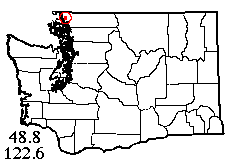 |
20 XI 2004: The last field trip of 2004 wasn't quite as serendipitous,
but it was educational. Jerry Austin and I had been planning a trip for some
time, the weather finally looked cooperative, and we flipped a virtual coin
deciding to go north rather than south. An old ecological publication refers
to a unique natural prairie area on a peninsula (Sandy Point) in northern Whatcom
County on the Lummi Indian Reservation. I already knew (from current topo maps)
that houses had since been built on the peninsula, but I was hoping a few feet
of natural habitat might have been preserved. No such luck - it's wall to wall
suburbia. At the base of the peninsula (head of Lummi Bay) there is still some
"unreclaimed" wetland which I thought might hold remnants of whatever species
were extirpated on the peninsula proper. But you can't get there from here.
Access on one side was blocked by trailers, on the other side by no-trespassing
signs. Some likely looking habitat to the north was fenced off with signs saying
it was reserved for recreation of Ferndale Refinery employees. For collecting,
we finally settled on an undistinguished (but open) tract of swampy alder forest
on the north border of the reservation.
It had evidently
frozen the previous night, and the leaf litter was still so cold that my hands
were freezing after sifting a few boxes full. So I bagged up a bunch to bring
back to the lab and process in the Berlese funnel. This worked out very well,
producing 14 of the 33 total spider species from the site. Understory foliage
beating, moss sifting, and the boughs of an isolated grand fir (of all things)
on a little mound in the swamp also yielded a nice variety of spiders, including
a few uncommon species. If my memory serves me right, Scarab Griswold recently
reported having 2,000-odd beetles in his collection. He could have increased
it by nearly 50% just from the one bag of leaf litter from the swamp that I
ran through the Berlese funnel - it had hundreds and hundreds of tiny beetles,
and a nice variety too.
This page last updated 21 March, 2025